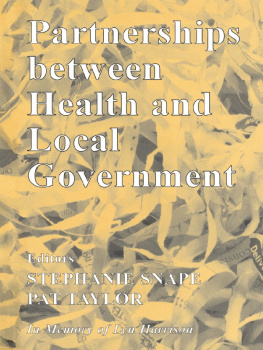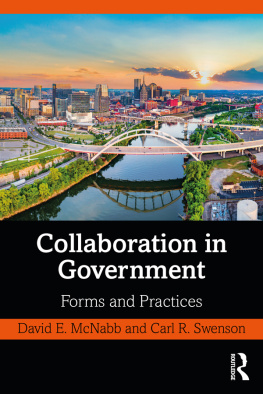BOOKS OF RELATED INTEREST
REGULATING LOCAL AUTHORITIES
Emerging Patterns of Central Control
Edited by Paul Carmichael and Arthur Midwinter
RENEWING LOCAL DEMOCRACY
The Modernisation Agenda in British Local Government
Edited by Lawrence Pratchett
LOCAL GOVERNMENT REORGANISATION
The Review and its Aftermath
Edited by Steve Leach
QUANGOS AND LOCAL GOVERNMENT
A Changing World
Edited by Howard Davis
FINANCING EUROPEAN LOCAL GOVERNMENTS
Edited by John Gibson and Richard Batley
THE POLITICAL EXECUTIVE
Politicians and Management in European Local Government
Edited by Richard Batley and Adrian Campbell
First published in 2004 in Great Britain by
FRANK CASS AND COMPANY LIMITED
Crown House, 47 Chase Side, Southgate, London N14 BP, England
This edition published in the Taylor & Francis e-Library, 2005.
To purchase your own copy of this or any of Taylor & Francis or Routledges collection of thousands of eBooks please go to www.eBookstore.tandf.co.uk.
and in the United States of America by
FRANK CASS PUBLISHERS
c/o International Specialized Book Services, Inc.
920 NE 58th Avenue, Suite 300
Portland, Oregon 9272133786
Copyright 2004 Frank Cass & Co. Ltd
Website: www.frankcass.co
British Library Cataloguing in Publication Data
Partnership between health and local government
1. Public health administrationGreat Britain 2. Local governmentGreat Britain 3. Medical policyGreat Britain 4. Great BritainSocial policy
I. Snape, Stephanie II. Taylor, Pat
353.60941
ISBN 0-203-50854-8 Master e-book ISBN
ISBN 0-203-58419-8 (Adobe eReader Format)
ISBN 0 7146 5537 6 (hb)
ISBN 0 7146 8425 2 (pb)
Library of Congress Cataloging-in-Publication Data
Partnerships between health and local government/editors, Stephanie Snape, Pat Taylor.
p. cm.
Includes bibliographical references and index.
ISBN 0-7146-5537-6 (Cloth)ISBN 0-7146-8425-2 (Paper)
1. Fundholding (Medical economics)Great BritainCitizen participation. 2. Medical policy Great BritainCitizen participation. I. Snape, Stephanie. II. Taylor, Pat, 1948 May 15III. Local government studies. IV. Title.
RA410.55.G7P37 2003
362.10941dc22 2003017596
This group of studies first appeared in a Special Issue of Local Government Studies (ISSN 0300-3930), Vol.29, No.3 (Autumn 2003)
[Partnerships between Health and Local Government].
All rights reserved. No part of this publication may be reproduced, stored in a retrieval system, or transmitted in any form, or by any means, electronic, mechanical, photocopying, recording or otherwise without the prior written permission of Frank Cass and Company Limited.
Partnerships between Health and Local Government: An Introduction
STEPHANIE SNAPE and PAT TAYLOR
The theme of this collection of essays is partnerships between health and local government. Interest in partnerships, and the range of joint working and collaborative activities undertaken within them, is not new. Nor is discussion of the merits (or otherwise) of collaboration between the two sectors; indeed, it is one of the hoary chestnuts of social policy. However, New Labours rise to power in 1997 has re-kindled an avid, acute interest in this old perennial. The governments emphasis on partnerships and collaboration was projected as a key element of the Third Way, New Labours self-proclaimed political philosophy. It was promoted as an antidote to the perceived damage done by the competitive ethos and market philosophy of the Conservative era. Partnership working was in particular viewed as the most appropriate means of addressing successfully those endemic social ills of society: low educational standards, social exclusion, poor health and poverty. No one agency could tackle such obdurate problems; these wicked issues cross organisational boundaries and require collaborative solutions.
New Labours enthusiasm for partnership approaches spawned many government reports, a range of area-based partnership initiatives, new powers and duties, incentives to collaborate and much exhortation to joint working. And in 1998, as the agenda of collaboration was being introduced, the Economic and Social Research Council (ESRC) commissioned a seminar series focused on the issue of improving partnerships between health and local government. The aim of the seminar series, organised by the Universities of Birmingham, Northumbria and the West of England, was to provide a forum to exchange knowledge, experience and ideas about the relationship between health and local authorities, to discuss effective models of joint working, and to facilitate collaborative research and publications. This seminar series provided the genesis of this special issue. All of the articles are based onand are developments from papers presented during the series, which ran during 1999 and 2000. It is not the only publication derived from the series. A number of practitioner-focused articles were published in a special issue of Local Governance (Ranade, 2001). This should be seen as an essential companion volume to this collection of essays, which comprises the more academic contributions to the series. The organisers would also like to take this opportunity to thank the ESRC for its support for the seminar programme.
This volume is dedicated to the memory of Lyn Harrison, who died in March 2001. Lyn worked for nearly 20 years at the University of Bristol in the School of Advanced Urban Studies (SAUS) and latterly in the School of Policy Studies. She spent much of that time researching, publishing and teaching in the area of joint working between health and local authorities and was an active contributor to the academic debate on joint working long before it was a key policy driver. Lyn was the rapporteur for the first ESRC seminar in Bristol in March 2000 and delivered a concise and critical analysis of the current partnership working agenda as a fitting conclusion to the debates at that seminar. Her long experience of partnership working would have been immensely valuable to the academic community at this time when there is such a focus on the need to evaluate and establish clear indicators for the value of partnerships. Her ability to see the wood from the trees as well as her loyalty, friendship and irreverent sense of humour is sadly missed by her colleagues at Bristol and within the organisations around the country in which she carried out her research and consultancy.
This introductory article seeks to provide what every teacher (and apt pupil) understands as the two key features of any introduction: an explanation and description of the context within which collaboration has yet again become a favoured activity in the public sector; and a clear structural map of the succeeding essays which form this special issue, which also signposts the key arguments and evidence to be presented by the various authors. The context for the special issue has been examined through exploring the interesting relationship between New Labours emphasis on partnership working and the debates about the nature of New Public Management (NPM). New Labours love affair with the partnership mode of governing has been pivotal in instigating a fundamental debate about the nature of the public sector (and its reform programmethe Modernisation Agenda) in the United Kingdom.
PARTNERSHIPS AND THE SEARCH FOR A SUCCESSOR TO NEW PUBLIC MANAGEMENT
Prior to 1997, academics had spent some years debating and refining the concept of NPM; a phrase which had been coined to describe a paradigm shift in public policy away from the Old Public Administration of bureaucracy, hierarchy and monolithic state provision to a New Public Management of an increasingly fragmented public sector, imbued with a managerialist culture and relationships based on competition and marketised notions of the customer. Hoods 1991 article in











